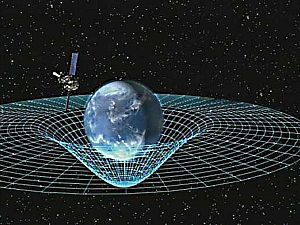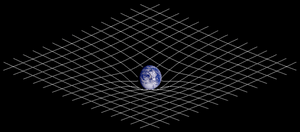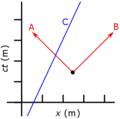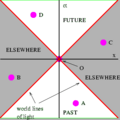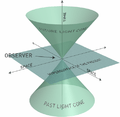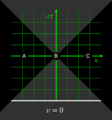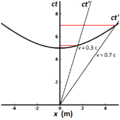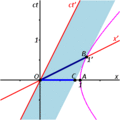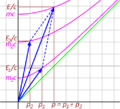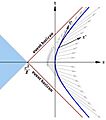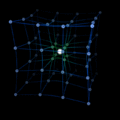Space-time facts for kids
Space-time is a way to think about space and time as one combined idea. Imagine space as the three directions you can move (up/down, left/right, forward/backward). Now, add time as a fourth direction. This four-dimensional idea is called a continuum.
This special way of looking at space and time helps scientists understand the universe. It helps explain how huge things like galaxies work. It also helps explain tiny things like atoms.
In everyday life, we usually think of time as always moving at the same speed for everyone. We also think of space as separate from time. This is how classical mechanics works.
But in the world of relativity, space and time are linked. How fast time passes can change depending on how fast something is moving. It also changes if an object is in a strong gravitational field. For example, time slows down near a very heavy object, like a planet, when seen by someone far away.
Contents
How Space-Time Bends
Wherever there is matter, like planets or stars, it bends space-time. Think of space-time like a giant trampoline. If you put a bowling ball on it, the trampoline sags. This sagging is like the bending of space-time.
This bending of space-time is what we feel as gravity. The white lines in the picture show how a heavy object changes the shape of space-time around it.
When things move very fast, close to the speed of light, time and space cannot be separated. How time passes for a fast-moving object looks different to someone standing still.
Who Discovered Space-Time?
Many people think Albert Einstein came up with space-time. He did propose his special relativity theory in 1905. However, it was Einstein's teacher, Hermann Minkowski, who first suggested the idea of space-time. He did this in an essay in 1908.
Minkowski's idea, called Minkowski space, was the first to combine space and time. He hoped this would make Einstein's special relativity theory clearer. Minkowski space works well for objects moving at a steady speed.
Later, Einstein took this idea further in his general relativity theory. He realized that the bending of space-time was actually the cause of gravity. He showed that space-time curves when objects speed up or slow down. Einstein discovered that this curve in his 4-dimensional space-time was what made gravity happen.
In 1926, the Encyclopædia Britannica even had an article about "space-time" written by Einstein himself.
Space-Time in Stories
The idea of space and time being connected isn't just for scientists. Writers have thought about it too!
Edgar Allan Poe wrote a long poem called Eureka in 1848. In it, he said that "space and duration are one." This was one of the first times someone suggested space and time were different parts of the same thing. Poe came to this idea without using any math.
In 1895, H. G. Wells wrote his famous novel, The Time Machine. In the book, he wrote, "There is no difference between Time and any of the three dimensions of Space except that our consciousness moves along it." He also added, "Scientific people…know very well that Time is only a kind of Space."
Space-Time and Tiny Particles
In Einstein's general relativity, space-time is seen as smooth and continuous. It's like a perfectly smooth sheet. However, in the world of quantum mechanics, which studies very tiny particles, space-time might not always be smooth. It could be bumpy or broken up at very small levels.
See also
Images for kids
See also
 In Spanish: Espacio-tiempo para niños
In Spanish: Espacio-tiempo para niños


